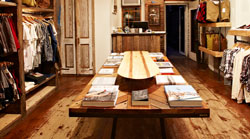A shopping centre is more than just bricks and mortar; it is a reflection of the evolution of consumers. Therefore, how a shopping centre's design reflects the values of its consumers plays an important role in its success.
This was according to Katherine Heiberg, CEO and Partner reteam: partner and co-founder mind16.com at the fourth South African Council of Shopping Centres (SACSC) annual research conference held recently at the Hilton in Sandton.
In previous eras, retailers knew their customers by name, their families and their histories, but the scale of the industry has grown so that we no longer know our customers says Heiberg.
The basics remain the same
She says while it may look different and we use different tools, the basics are the same. "However, while we may not know our customer, essentially he/she has not changed that much in 100 years. The customer still wants social interaction, to be inspired, to purchase something and to have a good life.
But what is happening is that we are in a paradigm shift where the landlord and the retailer must work together and merge. She calls it consumer demographics in a new context. The findings are a result of a research project, mind16.com.
"Consumption today is global, but with local values and is characterised by individualism, enhanced life choices and choice fatigue. We consume in a transparent world and we are connected 24/7," she explains.
Talk to their values
People behave according to different situations, not according to a group, but according to themselves. If you want their attention, you have to communicate to them by talking their values.
Why is this important? "The consumer influences how we design shopping centres. If you do not know your consumer, you will not design a centre that appeals to them. Mind16.com is about designing stores using an architectural language and incorporating the values of the people in the buildings," she says.
Moving inside the shopping centre and the store itself, Errol Solomon, head of visual merchandising and store design for Woolworths, explained why visual merchandising and store design go hand-in-hand and are so important to retailers' success in the future.
Clicks pose a threat to bricks
He told the audience that the rise of e-commerce is an increasing threat that faces bricks-and-mortar retailers in South Africa. "There has been a 7% growth in mall shopping, but a 30% increase in online shopping. With so many options around there is not much brand loyalty around either and the majority of people worldwide would not care if 73% of brands disappeared tomorrow."
Retailers therefore need to offer the consumer a new experience in-store. "How a brand looks, smells like, feels like etc is tactile and we still want to experience these," he says.

Surf’s up, dude – at Saturday Surf NYC.
There are a number of brands that are creating these experiences very successfully, such as Saturday Surf NYC. This store in New York conveys being passionate about surf. "Inside it feels like a surf club, customers feel like locals, and are able to linger as there is a bake and coffee area. At the back of the store, there is a patio to hang out. There are computers giving the latest surf conditions, magazines and you can even get a haircut in the store."
Another example he gave was Zara, which has a policy of zero advertising. "Instead, a percentage of their revenue goes to new stores in the most modern buildings in the best locations. These stores boast beautiful windows and these windows are their advertising. To achieve this they use the best mannequins and the styling of the products is on trend, while teaching and educating customers."
Consumers want more
The industry has never been as sophisticated as it is today. "This is because consumers are demanding more. They want entertainment, convenience, to express themselves and an experience. Therefore, store design and visual design not just window dressing, but the saviours of the future, he says.
Creating an experience at a shopping centre means the consumer is able to taste, smell, feel, see and hear that experience. This is what experiential marketing does and it is becoming more pronounced in the retail environment.
Mike Silver and Pete Hutchings from Stretch Experiential Marketing, explained to the delegates that centres cannot expect to do the same event year after year and expect the same results. "The stunts have to be bigger and more extreme. Having a big Xmas Tree for example is OK, but you need to go one step further. You need to create a destination out of your centre," they said. While overseas shopping centres are employing experiential marketing quite extensively, locally this is not the case.



























